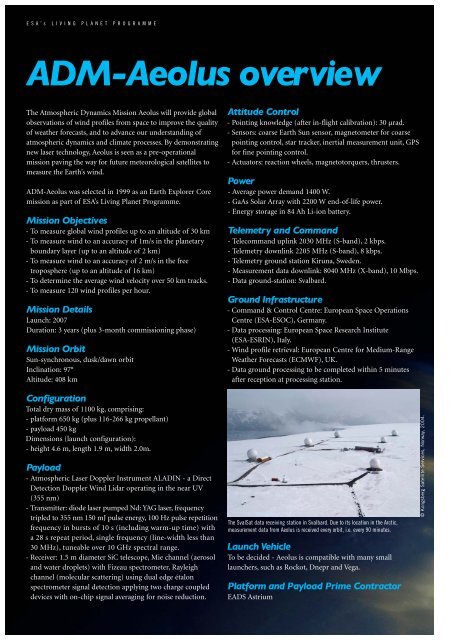ADM-Aeolus brochure (pdf) - ESA
ADM-Aeolus brochure (pdf) - ESA
ADM-Aeolus brochure (pdf) - ESA
You also want an ePaper? Increase the reach of your titles
YUMPU automatically turns print PDFs into web optimized ePapers that Google loves.
<strong>ESA</strong>’s LIVING PLANET PROGRAMME<br />
<strong>ADM</strong>-<strong>Aeolus</strong> overview<br />
The Atmospheric Dynamics Mission <strong>Aeolus</strong> will provide global<br />
observations of wind profiles from space to improve the quality<br />
of weather forecasts, and to advance our understanding of<br />
atmospheric dynamics and climate processes. By demonstrating<br />
new laser technology, <strong>Aeolus</strong> is seen as a pre-operational<br />
mission paving the way for future meteorological satellites to<br />
measure the Earth’s wind.<br />
<strong>ADM</strong>-<strong>Aeolus</strong> was selected in 1999 as an Earth Explorer Core<br />
mission as part of <strong>ESA</strong>’s Living Planet Programme.<br />
Mission Objectives<br />
- To measure global wind profiles up to an altitude of 30 km<br />
- To measure wind to an accuracy of 1m/s in the planetary<br />
boundary layer (up to an altitude of 2 km)<br />
- To measure wind to an accuracy of 2 m/s in the free<br />
troposphere (up to an altitude of 16 km)<br />
- To determine the average wind velocity over 50 km tracks.<br />
- To measure 120 wind profiles per hour.<br />
Mission Details<br />
Launch: 2007<br />
Duration: 3 years (plus 3-month commissioning phase)<br />
Mission Orbit<br />
Sun-synchronous, dusk/dawn orbit<br />
Inclination: 97°<br />
Altitude: 408 km<br />
Configuration<br />
Total dry mass of 1100 kg, comprising:<br />
- platform 650 kg (plus 116-266 kg propellant)<br />
- payload 450 kg<br />
Dimensions (launch configuration):<br />
- height 4.6 m, length 1.9 m, width 2.0m.<br />
Payload<br />
- Atmospheric Laser Doppler Instrument ALADIN - a Direct<br />
Detection Doppler Wind Lidar operating in the near UV<br />
(355 nm)<br />
- Transmitter: diode laser pumped Nd: YAG laser, frequency<br />
tripled to 355 nm 150 mJ pulse energy, 100 Hz pulse repetition<br />
frequency in bursts of 10 s (including warm-up time) with<br />
a 28 s repeat period, single frequency (line-width less than<br />
30 MHz), tuneable over 10 GHz spectral range.<br />
- Receiver: 1.5 m diameter SiC telescope, Mie channel (aerosol<br />
and water droplets) with Fizeau spectrometer, Rayleigh<br />
channel (molecular scattering) using dual edge étalon<br />
spectrometer signal detection applying two charge coupled<br />
devices with on-chip signal averaging for noise reduction.<br />
Attitude Control<br />
- Pointing knowledge (after in-flight calibration): 30 µrad.<br />
- Sensors: coarse Earth Sun sensor, magnetometer for coarse<br />
pointing control, star tracker, inertial measurement unit, GPS<br />
for fine pointing control.<br />
- Actuators: reaction wheels, magnetotorquers, thrusters.<br />
Power<br />
- Average power demand 1400 W.<br />
- GaAs Solar Array with 2200 W end-of-life power.<br />
- Energy storage in 84 Ah Li-ion battery.<br />
Telemetry and Command<br />
- Telecommand uplink 2030 MHz (S-band), 2 kbps.<br />
- Telemetry downlink 2205 MHz (S-band), 8 kbps.<br />
- Telemetry ground station Kiruna, Sweden.<br />
- Measurement data downlink: 8040 MHz (X-band), 10 Mbps.<br />
- Data ground-station: Svalbard.<br />
Ground Infrastructure<br />
- Command & Control Centre: European Space Operations<br />
Centre (<strong>ESA</strong>-ESOC), Germany.<br />
- Data processing: European Space Research Institute<br />
(<strong>ESA</strong>-ESRIN), Italy.<br />
- Wind profile retrieval: European Centre for Medium-Range<br />
Weather Forecasts (ECMWF), UK.<br />
- Data ground processing to be completed within 5 minutes<br />
after reception at processing station.<br />
The SvalSat data receiving station in Svalbard. Due to its location in the Arctic,<br />
measurement data from <strong>Aeolus</strong> is received every orbit, i.e. every 90 minutes.<br />
Launch Vehicle<br />
To be decided - <strong>Aeolus</strong> is compatible with many small<br />
launchers, such as Rockot, Dnepr and Vega.<br />
Platform and Payload Prime Contractor<br />
EADS Astrium<br />
© Kongsberg Satellite Services, Norway, 2004.

















